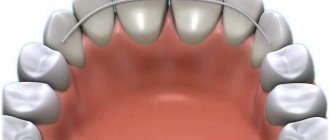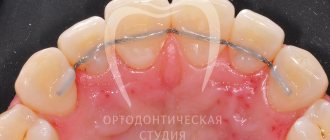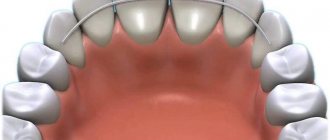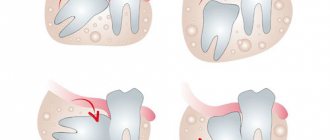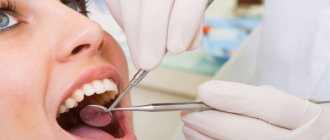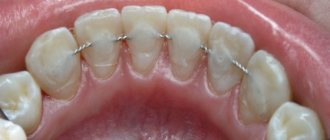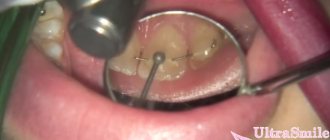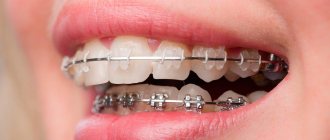This is a headache and a nightmare for any orthodontist: a patient who has had his braces removed and given a removable retainer and instructions for its use returns after some time with complaints about the curvature of his previously straight teeth. The retention period is the most psychologically difficult part of the treatment. Everything is already perfect, and then you have to wear a retainer. Yes, there are other reasons for the unsuccessful outcome of the correction. And although they are much less common, let’s talk about them in more detail.
Correction principle
The method of correcting malocclusion with braces is based on the principle of creating constant pressure on the teeth. Under pressure, the tooth root begins to press on the socket on one side, thereby causing rarefaction of the bone tissue. In the direction of rarefaction, the tooth moves. On the other side of the hole, bone tissue, on the contrary, grows. Thus, after a certain period of time, not only the position of the tooth changes, but also the shape of the socket, which prevents the tooth from returning to its original place.
Correct your bite or dental defect with invisible aligners Find out what it is
Bone tissue grows quite quickly, but it takes quite a long time to “ripen”. That is why, after finishing wearing the brace system, a removable retainer is made for the patient for another year or two or a splint is installed on the incisors and canines. Additional fixation during the retention period helps to avoid repeated tooth curvature.
Gaps between teeth: classification, causes
A variety of reasons can lead to the appearance of three:
- Often we are talking about hereditary predisposition. If at least one parent has trema or diastema, the risk that the child will encounter the same problem is 30%;
- Sometimes the appearance of gaps between teeth is a consequence of bad habits. Among those people who often chew pens and pencils, the percentage of those suffering from gaps between teeth is significantly higher than among those who are free from such habits;
- loss of teeth. The loss of a tooth entails many problems: this is atrophy of bone tissue, this is the process of moving apart the remaining teeth, which entails the appearance of teeth. The displacement of teeth leads to a deformation of the bite, to a change in the entire process of chewing food, and this can negatively affect the functioning of the gastrointestinal tract and human health in general. That is why dentists recommend not to delay and carry out full dental prosthetics.
Depending on which teeth, milk or permanent, we are talking about, trema and diastema are divided into two groups: false and true. Trema are called false if they form between baby teeth, true - respectively, between permanent teeth. A false trema does not always degenerate into a true one, but this is a clear reason for parents to pay attention to the condition of their child’s oral cavity. Make an appointment with an orthodontist and follow his instructions - this will help you minimize the risk of gaps between your permanent teeth.
Possible problems after removing braces
Some people's teeth diverge quickly after completing the correction stage. During the first year, some individuals may only slightly rotate around their axis. Everything is individual, but some general patterns can be identified.
Fanned teeth
A rapid relapse after braces are removed may be due to the following factors:
- Refusal of retainers. Patients often refuse permanent retainers because their installation damages tooth enamel. And it’s annoying to wear removable retainers, even those that are worn only at night. As a result, the teeth return to their previous position, since the new position has not yet been “overgrown” with bone tissue.
- Individual characteristics. There are people in whom new formation and “maturation” of bone tissue proceeds faster than others. And there are those for whom this process is delayed. For some, the displacement of teeth in order to correct the shape of the dentition was insignificant, while for others the tooth “came a long way” before taking its place in the dentition. Teeth quickly “huddle together” after crowding is eliminated. The teeth, which were mixed with braces around their axis, easily turn back.
- Breakage of braces, use of a system of inadequate quality. If the pressure on the teeth during correction was not constant, then the likelihood of an unfavorable outcome increases. You shouldn’t walk around with a broken arch or unstuck locks for a week. It is better to see a doctor on the same day. This will save you from many problems.
- Tooth extraction. When there is not enough space for teeth in the dentition, the orthodontist may decide to remove the “extra” ones. Most often these are fours, eights, less often sixes. The absence of fangs can cause the formation of a diastema. Removing a six causes significant displacement of adjacent teeth.
Loose teeth after braces
Occurs infrequently. In most cases, the feeling of excessive tooth mobility after removing braces is deceptive. It may appear at the very beginning of the retention period and disappear on its own and without treatment. It's another matter if the teeth are really loose. In this case, it is better to seek help from a specialist.
Pain in the teeth and gums
There may be some discomfort after removing braces. Pain occurs especially often after eating solid foods. The reason for this is a change in the condition of the ligaments that hold the roots of the teeth, as well as an increase in the sensitivity of the enamel if the remineralization procedure was not carried out. Reducing the chewing load and using special medications that reduce the sensitivity of teeth and gums help reduce pain.
How to correct a protruding jaw?
It is possible to correct a protruding upper or lower jaw, but it is worth keeping in mind that this is a long process that will require time and effort. The easiest way to correct a protruding jaw is in childhood: bones that are in the process of growth are easier to manipulate. In adults, correction of the mesial bite can take several years.
All treatment methods can be divided into three categories.
Gentle treatment - mainly used to correct protruding jaws in children under 12-13 years of age. As a rule, it involves inhibiting the growth of one of the jaws and stimulating the development of the other.
- Massaging the bone of the alveolar ridge is a stimulating effect that accelerates the development of the jaw.
- Wearing orthodontic structures - mouthguards, braces and trainers. Removable structures (trainers or LM activators) are effective starting from the period of primary occlusion. They can be used in the preparatory period before installing braces, thereby reducing the time of orthodontic treatment.
- Myofunctional gymnastics aimed at training the facial muscles. Orthodontists recommend starting to do such exercises for children from 2.5 to 3 years old, which will normalize maxillofacial development.
- Using vestibular plates to combat bad habits. Such techniques are used for primary and mixed dentition (aged 3 to 9 years), they are necessary to eliminate myofunctional disorders in the growing body. At the same time, the effectiveness of the exercises significantly increases (daytime training for 1 - 2 hours and wearing the device at night).
Orthodontic treatment
- This is a gradual correction of the position of the jaw using special devices that must be worn every day for a certain time (or constantly). In addition to the well-known brace systems (read more about braces in the article), more complex designs can be used. They change the direction of bone growth, pull the “lagging” jaw forward, expand the dentition, align and move teeth in the right direction. There are intraoral and extraoral systems. They are quite effective, but wearing them is associated with certain restrictions.
Surgical treatment
— surgical correction of a protruded jaw.
- Plastic surgery (trimming) of the frenulum of the tongue is prescribed for children 5-6 years old and can effectively correct the bite during the period of changing teeth.
- Tooth extraction helps reduce the size of an overdeveloped jaw.
- Osteotomy is a radical way to get rid of a protruding jaw. Prescribed to patients over 18 years of age when other methods are ineffective or have failed. During the operation, the jawbone is sawed, placed in the desired position and fixed with titanium structures. Read more about orthoganic surgery here.
Treatment of diastemas with before and after photos
From this article you will learn about the causes of diastema, ways to eliminate the gap between the front teeth with before and after photos, as well as prevention methods. In adults and in children.
Dental diastema is the distance between the front central incisors. Happens to 10 - 20% of people. More often found on the upper jaw, less often on the lower jaw.
For some, the gap between the front teeth is an aesthetic “highlight” of a person, but it can negatively affect diction - whistling sounds. This defect can be left unchanged. There are negative consequences of this inaction. About them at the end of the article.
Causes:
- 1. Small size of incisors (1-2%).
- 2. Incorrect position of the front teeth due to malocclusion (4-7%).
- 3. Displacement of the front teeth due to increased load due to the loss of chewing teeth (5-8%).
- 4. But the main reason is one (up to 90%) - the presence of a pronounced frenulum of the lip, which prevents the central teeth from being next to each other.
Types of diastemas
- false - with baby teeth. It can close on its own when the permanent ones erupt.
- true - when all permanent teeth are already in place.
Prevention and treatment in children
With the help of a banal micro surgical intervention - trimming the frenulum of the upper lip. Then the gap will close itself in adolescence. If this graceful time is missed, it will have to be eliminated in the future by other means.
Restoration of diastemas with composite material
When all the teeth are in a normal position and the only concern is the distance between the front teeth, this can be beautifully, easily and quickly corrected with a composite material. In the patient's mouth for an hour and a half. This type of correction is called a filling, artistic restoration, or direct veneer. how it's done
- A composite material is applied to the lateral surfaces of the teeth without treatment, changing their shape and closing the gap between the teeth.
deadlines
- It will take one to two hours for both teeth.
pros
- This is the most non-traumatic
way to eliminate diastema. - The fastest way to close diastemas of all.
- Complete absence of dental treatment. No boron! Absolutely atraumatic for teeth and their nerves.
- No negative impact on the tooth and nerve.
- The likelihood of dental problems is the same as without intervention.
- The strength of the teeth is not impaired - you can bite off any acceptable food.
minuses
- We need a highly qualified dentist. With a lot of experience. Otherwise, closing the diastema will look like a filling and not an artistic restoration.
- The doctor must have a variety of aesthetic and proven materials available. To eliminate the defect beautifully and permanently. If performed poorly, the appearance of the teeth will not be ideal.
- When the distance between the front teeth is more than 2mm, the results are not always ideal:
In such cases, treatment with braces is more suitable. Or you have to use the lateral incisors. To prevent the central ones from becoming too wide: cost
- 6600-13200 rubles for one direct veneer. Depends on the scope of the intervention.
forecast
- When the work is done by a true master, composite veneers will last up to 10 - 16 years.
- Poor oral hygiene may require polishing. Once every two to four years. Takes 15-20 minutes. Costs up to 600 rubles.
- Due to the lack of treatment of the teeth, there is no effect on the nerve of the tooth. Therefore, there can be no complications.
Symptoms
In some situations, loosening of elements is considered a sign of pathology. There are clinical situations when patients develop inflammation in the hard tissues or oral mucosa during treatment.
It is recommended to seek dental care if the following warning signs appear:
- Redness, swelling and bleeding of mucous tissue.
- Molar caries.
- Erosions and ulcers on the gums and inner surface of the cheeks.
- Increased abrasion of enamel.
- Pain in certain areas of the jaw.
- Discharge of pus.
These symptoms indicate the development of serious dental diseases that require urgent treatment. In the absence of proper treatment, there is a risk of destruction or loss of units, the occurrence of purulent-inflammatory processes and other complications.
The causes of loose teeth are lack of regular oral hygiene, jaw injuries and non-compliance with medical recommendations.
